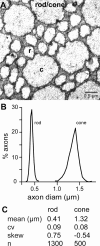Why do axons differ in caliber?
- PMID: 22238098
- PMCID: PMC3571697
- DOI: 10.1523/JNEUROSCI.4254-11.2012
Why do axons differ in caliber?
Abstract
CNS axons differ in diameter (d) by nearly 100-fold (∼0.1-10 μm); therefore, they differ in cross-sectional area (d(2)) and volume by nearly 10,000-fold. If, as found for optic nerve, mitochondrial volume fraction is constant with axon diameter, energy capacity would rise with axon volume, also as d(2). We asked, given constraints on space and energy, what functional requirements set an axon's diameter? Surveying 16 fiber groups spanning nearly the full range of diameters in five species (guinea pig, rat, monkey, locust, octopus), we found the following: (1) thin axons are most numerous; (2) mean firing frequencies, estimated for nine of the identified axon classes, are low for thin fibers and high for thick ones, ranging from ∼1 to >100 Hz; (3) a tract's distribution of fiber diameters, whether narrow or broad, and whether symmetric or skewed, reflects heterogeneity of information rates conveyed by its individual fibers; and (4) mitochondrial volume/axon length rises ≥d(2). To explain the pressure toward thin diameters, we note an established law of diminishing returns: an axon, to double its information rate, must more than double its firing rate. Since diameter is apparently linear with firing rate, doubling information rate would more than quadruple an axon's volume and energy use. Thicker axons may be needed to encode features that cannot be efficiently decoded if their information is spread over several low-rate channels. Thus, information rate may be the main variable that sets axon caliber, with axons constrained to deliver information at the lowest acceptable rate.
Figures









References
Publication types
MeSH terms
Grants and funding
LinkOut - more resources
Full Text Sources
